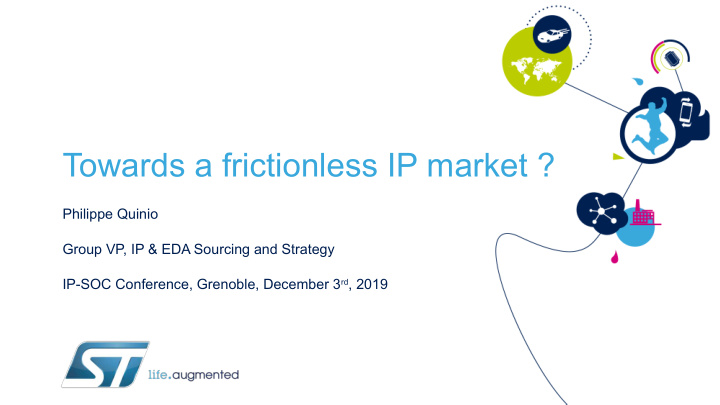



Towards a frictionless IP market ? Philippe Quinio Group VP, IP & EDA Sourcing and Strategy IP-SOC Conference, Grenoble, December 3 rd , 2019
The ingredients of a well-functioning market 2 Asset liquidity Ability to buy and sell fast What is sold and terms of sale are known to market players At low transaction costs Trade Market Transparency Efficiency Source: SHORTCOMINGS ON THE MARKET FOR INTELLECTUAL PROPERTY, FRAUNHOFER CENTER FOR INTERNATIONAL MANAGEMENT AND KNOWLEDGE ECONOMY, March 2016
Real markets have friction 3 Asset liquidity Friction Friction Trade Market Transparency Efficiency Source: SHORTCOMINGS ON THE MARKET FOR INTELLECTUAL PROPERTY, FRAUNHOFER CENTER FOR INTERNATIONAL MANAGEMENT AND KNOWLEDGE ECONOMY, March 2016
Sources of friction in real markets 4 • Imperfect information • Asymmetric information • Asset Specificity/Uniqueness • Externalities combined with positive transaction costs • Spillovers • Uncertainty • Indivisibilities (production economies of scale) • Undefined and Poorly-Defined Property Rights Source: Market Frictions, Governance and Economic Rents: Taking Stock and Looking Ahead, Joseph T. Mahoney & Lihong Qian , University of Illinois at Urbana−Champaign, College of Business, 2009
Sources of friction in the Design IP market 5 • Imperfect information IP buyers struggle to understand the real maturity and quality of IP designs • Asymmetric information • Asset Specificity/Uniqueness IPs are often customized (eg Hard IPs) and become unique • Externalities combined with positive transaction costs • Spillovers Concurrent engineering implies technical risks and uncertainty • Uncertainty Large suppliers can leverage re-use • Indivisibilities (production economies of scale) of IP blocks, investment in validation method and quality systems, etc. • Undefined and Poorly-Defined Property Rights Threat of infringement claims blurs IP ownership Source: Market Frictions, Governance and Economic Rents: Taking Stock and Looking Ahead, Joseph T. Mahoney & Lihong Qian , University of Illinois at Urbana−Champaign, College of Business, 2009
IP Buyers aggregate market frictions into Sourcing Risks 6 Ability to fix bugs in H/W and S/W deliverables throughout product life is limited by company resources and opaque governance Small size, family governance and potentially hostile shareholder ties implies higher risk in ability to technically support H/W and S/W deliverables throughout product life Ability to defend and indemnify ST in case of 3 rd party IPR infringement claims is limited by company resources and low contractual indemnity cap Market adoption (content ecosystem) risk higher with mkt challenger than with leader Source: Assessing & Managing the IP Sourcing Risk, Ph. Quinio , DATE 2015
IP Buyers end-up making a call between 7 sourcing risk and costs Aggregate sourcing risk Aggregate sourcing cost Source: Assessing & Managing the IP Sourcing Risk, Ph. Quinio , DATE 2015
Consequences of market frictions for IP Sellers 8 • Small IP suppliers sometimes get disqualified by corporate IP sourcing teams due to perceived risks • Unless they can provide compelling evidence of IP maturity and design robustness/quality, smaller suppliers must charge a lower price for their IPs • Small IP suppliers should carry a strong-enough balance sheet to be able to honor indemnification commitments • Small IP suppliers should keep sufficient engineering resources to address unexpected IP changes and support obligations • Small IP suppliers must be generous with « evaluation » licenses so as to convince customers of IP’s compliance to spec
Towards a frictionless IP market? 9 • Can a web-based IP exchange platform and standard address concerns and reduce IP market friction? • Widely accepted IP maturity system • Certification for IP quality and maturity • Simple IP delivery system • Lower transaction costs owing to mutualized services (eg. legal) • Mutualized insurance policy backing indemnification • More transparent specifications, prices and terms
Recommend
More recommend